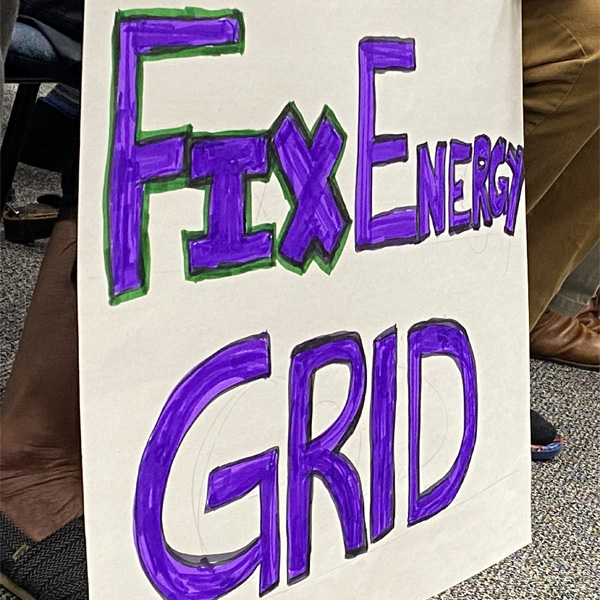New Jersey is studying how to set data-gathering rules to ensure that the growing implementation of advanced metering infrastructure (AMI) helps ratepayers cut energy use and support efforts to meet the state’s ambitious clean energy goals.
The state’s Board of Public Utilities (BPU) will hold a second hearing on Sept. 6 into its straw proposal intended to ensure that ratepayers and other stakeholders can get speedy, accurate data on which to make energy decisions while protecting the privacy of consumers and securing the system.
State officials believe AMI is an important element to implementing Gov. Phil Murphy’s Energy Master Plan, which sets a state goal of 100% clean energy by 2050. It calls AMI a “foundational component of a modernized electric distribution grid” and describes it as “a prerequisite of many additional clean energy objectives.”
AMI is the use of “smart” meters that can compile data on a ratepayer’s energy use and transmit it to the user or third party, often in real time. Analysis of the data can help the ratepayer adjust their energy use, facilitating changes such as shifting the time of day for completing tasks to when energy is cheaper, halting some practices or allowing the user to switch away from high energy-consuming appliances.
The first utility in the state to implement an AMI strategy, Rockland Electric Co., installed about 74,000 smart meters by 2019. The state expects its other three utilities to deploy more than 3.9 million smart meters over the next five years.
Benefits of AMI
The straw proposal, released a year ago, would create a standardized system of rules that govern how utilities handle issues such as data sharing, data access, data privacy and billing reconciliation. The state’s four utilities would each be required to file data access plans to implement the rules.
AMI “holds the potential to be an integral part of New Jersey’s clean energy transition, enhance retail competition and efficiencies, and enable customers to better understand and control their own energy usage,” the proposal says.
The straw proposal emphasizes that the data, although often collected by the utility, are owned by ratepayers, who should control who can access them and whether that should include third parties. The BPU’s plan recommends the use of the “Green Button Connect” system, a standardized, relatively user-friendly system through which ratepayers can access their own data through a green button on their utility company’s website. The proposal also would require utilities to follow standard cybersecurity measures to protect the data.
Metrics that should be collected, according to the proposal, include: total usage and demand in kilowatt-hours, the number of customers who access the data, and how many customers sign up for energy-saving tools, energy-usage information and saving tips.
Speakers told the first hearing on the proposal Aug. 16 that the speed at which data become available is important to ensuring their value and to keeping consumers focused on their energy usage.
“Energy data is a highly fungible commodity whose value is maximized when accessed and interpreted shortly after the energy consumption,” said Christopher Oprysk, an engineer at the BPU who presented parts of the proposal at the hearing. “Consumers are more likely to respond with behavior changes if the data reflects recent consumption patterns and more closely ties [it] to cause and effect.”
The proposal argues that “billable data,” which are collected by the utilities to calculate ratepayer bills, should be available within 48 hours and customers should be provided with an energy monitoring device that would make available unvalidated data within 15 seconds, which could be accessed through a home area network.
Murray Bevan, a lobbyist for several energy suppliers, including NRG Energy and Vistra, echoed the point, telling the BPU that rapid access to data is critical.
“If I run my dishwasher at 4 in the afternoon, or I run it at 10 at night, there’s like a 40% difference in the price of running it,” he said. “So if I really need the clean dishes for dinner at 6 or 7, OK, I’ll go ahead and run it. But if I can wait until 10, that’s a significant price win.”
“Getting the data as close to the real time usage as possible, is the most valuable,” he said. “If I’m making this decision on Monday, and I’ve learned about it, that I should have run the dishwasher at 10, on Tuesday or Wednesday, obviously that’s not as valuable to the customers.”
AMI Implementation Surge
The BPU in January gave approval to a plan by Public Service Electric and Gas to invest $700 million over the next four years to provide smart meters to its 2.3 million electricity customers. The company at the time said the move would “help expedite electric service restorations when severe weather strikes, help customers increase their home energy savings and improve service quality.”
In July 2021 the board approved a plan a plan by Atlantic City Electric to spend $177 million on installing 565,000 smart meters. And the state’s fourth utility, Jersey Central Power & Light, has a plan before the BPU to spend $360 million on AMI.
Yet the state’s adoption of AMI has lagged, even as other states have embraced the technology. There were 94.4 million advanced meters in operation as of 2019, the latest that figures are available, according to FERC’s annual Assessment of Demand Response and Advanced Metering report released in December. That accounted for 60.3% of the meters of all types operating in the country and was an increase of 8 million smart meters over the year before, the report said.
The Mid-Atlantic region had the second worst penetration in the nation, with only 37.4% of the meters being advanced, the report said. The worst was New England, with 22% penetration, while the highest penetration was in the West South Central Region, which includes Texas, and the Pacific region, both with about 74% penetration.
Yet even those areas in which AMI penetration is high, the technology may not be fully used, according to a study that Mission:data, a nonprofit advocacy organization that works to promote AMI usage, is set to release next week. More than a decade after the federal American Recovery and Reinvestment Act (ARRA) disbursed $3 billion for AMI projects, “most of the data-access benefits promised to customers have been deactivated,” the report says. Only about 2.9% of the 17.4 million advanced meters funded by the program are enabled, the report says.
Still, New Jersey’s slow uptake could end up helping the state, said Michael Murray, president of Mission:data. The state can learn from projects in other states where “customer benefits of smart meters have not materialized,” he said in an interview with NetZero Insider. And the state’s program could be bolstered by the recently enacted Inflation Reduction Act, which includes funds that can be used for AMI, he said.
While some consumer advocates are skeptical that the benefits from AMI are worth the investment, a dozen studies have shown that “6 to 18% energy savings are possible when consumers have easy, electronic access to their meter data,” he said. Aside from helping customers cut energy use, AMI data can help them buy the right size of appliance they need based on actual electricity use and can help with the purchase of energy-efficient equipment such as heat pumps.


